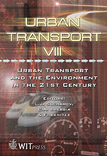A Study Of Highway Noise Pollution In Tehran
Price
Free (open access)
Transaction
Volume
60
Pages
7
Published
2002
Size
367 kb
Paper DOI
10.2495/UT020641
Copyright
WIT Press
Author(s)
M. Vaziri
Abstract
Urban noise pollution has been a steadily growing problem for developing countries. Urban growth is accompanied by increased highway traffic which is a major contributor to noise pollution. Control laws and management rarely accompany the noise pollution growth. The Greater Tehran Metropolitan Area, GTMA, inhabitants along major highways are being continuously exposed to severe traffic noise health hazards. The objective of this research was to evaluate and model noise pollution due to highway traffic in the GTMA The study database consisted of relevant information about the noise level, traffic, roadway and meteorological characteristics. The collected noise level information at the roadway sound level meter receptor site included equivalent noise level. The traffic information included traffic flows, traffic speed and composition. The roadway information included number of lanes, median type, roadway functional and location types. The meteorological information included air temperature. The univariate statistical analysis of the database shed some lights on the GTMA noise pollution. The noise level measured at reception points along the GTMA highways was found often in breach of noise standards. The noise level was found significantly correlated with distance from the roadway, traffic conditions, roadway conditions and local weather characteristics. The stepwise multiple regression analysis was used to develop highway noise level descriptive models. These models proved to be simple tools for noise level prediction and management. Although the study findings are for the GTMA and problem specific, the same methodology can be applied in any urban transportation noise pollution study.
Keywords





